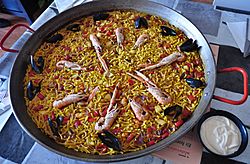Fideuà facts for kids
 |
|
| Course | Pasta |
|---|---|
| Place of origin | Spain |
| Region or state | Valencia |
| Main ingredients | Vermicelli, white-fleshed fish, crustaceans |
Fideuà is a tasty seafood dish from the coast of Valencia, Spain. It looks a lot like paella, but instead of rice, it uses noodles! The name fideuà comes from a Valencian word meaning "a large amount of noodles."
This yummy meal is made with pasta noodles, often hollow ones. It also includes different kinds of fish, like rockfish or monkfish. You'll find shellfish too, such as shrimp or crayfish. A squeeze of fresh lemon is often added for extra flavor.
How Fideuà Was Invented
The story of how fideuà was created is quite interesting! It started with a cook named Gabriel Rodríguez Pastor, also known as Gabrielo. He worked on a fishing boat in the port of Grau in Gandía. Juan Bautista Pascual, called Zábalo, was his young assistant.
The captain of their boat really loved arròs a banda, a rice dish Gabrielo often made. The problem was, the captain loved it so much that the other sailors hardly ever got enough to eat!
To solve this, Gabrielo had a clever idea. He decided to use noodles instead of rice. He hoped this new version would be a little less tempting for the captain. That way, everyone on the boat might get their fair share.
But guess what? Everyone loved the noodle dish! The news of this new meal, the fideuà, quickly spread. Soon, restaurants in the harbor, like "Pastaora House," started making it. Fideuà became a special and important dish in the area.
What Makes Fideuà Special
Just like paella, fideuà is cooked in a special wide, flat pan. This pan is also called a paella pan. Sometimes, people make fideuà in traditional casserole dishes too.
A key part of making fideuà is how the pasta is cooked. Instead of just boiling the noodles, they are first sautéed (lightly fried) in a flavorful fish stock. This gives the noodles a wonderful taste and texture.
Gandia is known as the birthplace of fideuà. Every year, this city in the La Safor region hosts a big competition. The best cooks come together to show off their skills and try to make the most delicious fideuà!
See also
 In Spanish: Fideuá para niños
In Spanish: Fideuá para niños

